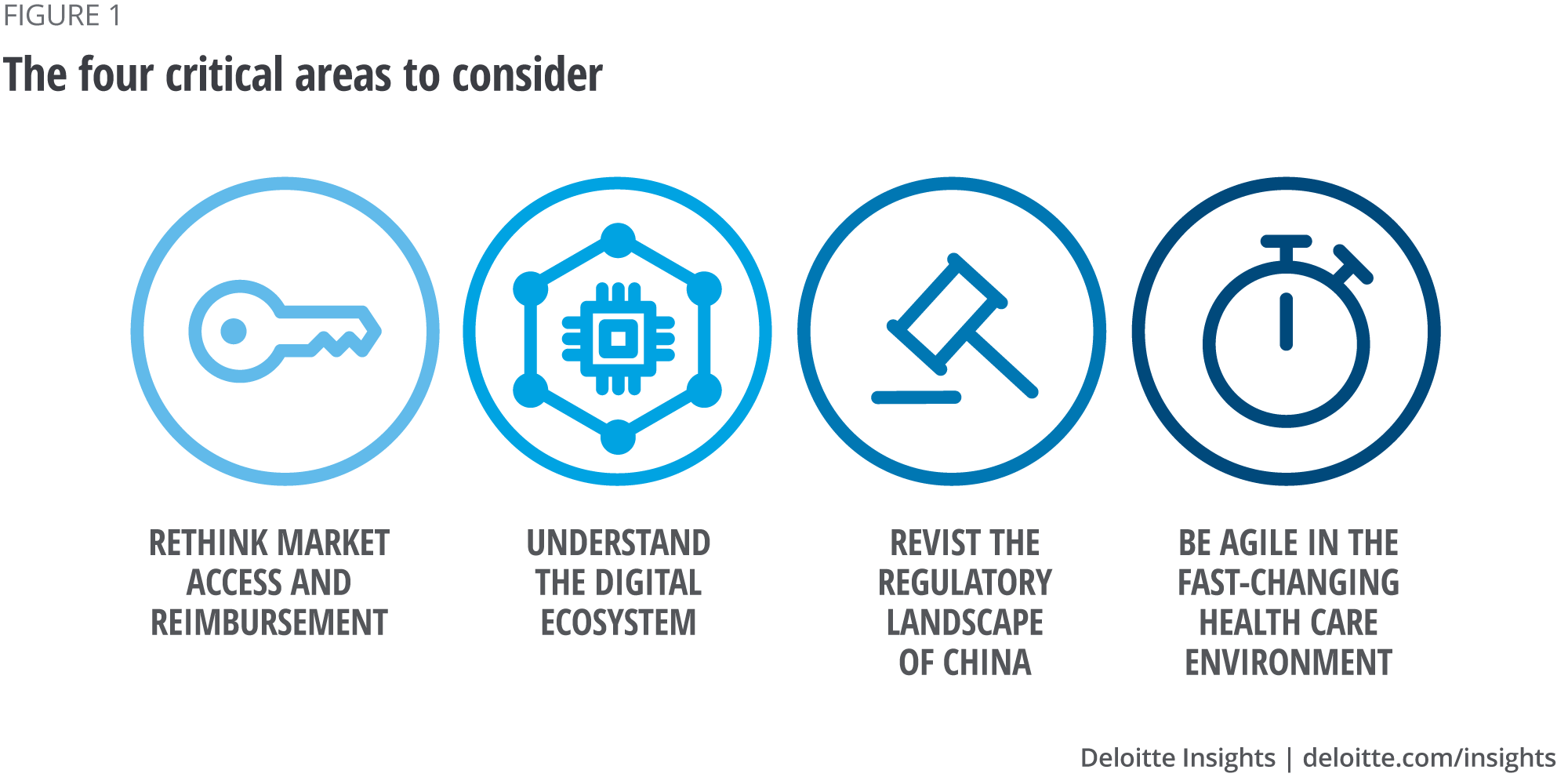
Gain the edge in a fast-moving market Launching innovative biopharma in China
5 minute read
15 March 2019
Biopharma companies looking to launch innovative medicines in China can pull ahead in the race by taking advantage of key cultural and regulatory conditions. Deloitte introduces a series of four articles that break down the dynamics of a successful launch.
China has swiftly become one of the largest biopharmaceuticals (biopharma) and medical products markets in the world, projected to reach $145-175 billion in sales by 2022.1 Quicker regulatory approval and widening market access are among the profound changes that have made China a significant market for biopharma companies to launch innovative medical products. But the vast majority of firms are often disappointed by their commercial launches in China. The companies that succeed begin their launch preparation and planning early – absorbing a deep understanding of the country’s dynamic system, implementing strong organisational capabilities and developing an agile approach.
Learn More
Explore the Launching innovative biopharma in China series
View the Life Sciences collection
Subscribe to receive more information about innovative biopharma in China
In a hurry? Read a brief version from Deloitte Review, issue 25
Download the issue
Download the Deloitte Insights and Dow Jones app
China’s fast-moving health care industry landscape and unique market characteristics often demand that a biopharma company or biological/ chemical medicine manufacturer adopt a ‘China perspective’, with a launch strategy that differs from those used in the west. Deloitte’s recent experience supporting biopharma companies has enabled us to identify the following four critical areas that support such a strategy and are crucial to a successful launch in China.
1. Rethink market access and reimbursement
Market access in China is evolving rapidly. Since 2017 the country has approved a record number of innovative foreign drugs.2 These approvals follow a series of policy moves to provide public funding, enabling a population of 1.4 billion to access new and life-saving drugs – especially cancer therapies. Before that, it was difficult for innovative medicines to achieve reimbursement. From 2001 to 2016, the national reimbursement drug list (NRDL; a list of drugs for which the government pays some or all of the cost) was updated only three times with limited inclusion of innovative medicines.3
China updated its NRDL in both 2017 and 2018. An important development was a new price negotiation mechanism. Following a small pilot in 2015, 45 medicines were invited into price negotiations in 2017; 36 of those, including some established blockbuster products, reached agreements to join the NRDL.4 However, success came at a cost – an average price cut of 44 per cent. In 2018 another 17 cancer drugs were added to the NRDL with an average 57 per cent discount.5 Drug makers are having to slash prices so that the Chinese government will cover the costs of some advanced treatments.6
In contrast to the NRDL norm of reimbursing established products, ten of the 17 drugs added in 2018 were new products: a positive sign that reimbursement in China may now happen more quickly. Moreover, subnational payers and private insurers have also been proactive in experimenting and piloting different programmes (such as outcome-based schemes) to enhance patient access.
The new price negotiation mechanism requires companies to exhaustively explore the options surrounding a potential trade-off of price and/or volumes that can be sold. They must also evaluate the brand opportunity in a more sophisticated way than the traditional assessment for a self-pay market. Companies that want to succeed in launching products must stay on top of the changing dynamics and continue to explore new access options for patients.
2. Understand the digital ecosystem
Traditionally, China has had a ‘face-to-face’ business culture. However, thanks to large, government-led infrastructure programmes and investment, the country is now leading the way in digital innovation. Through the widespread adoption of smart devices, and innovative digital applications and tools, China has become a mobile-first economy.
Patients and physicians are both changing their behaviour in this new digital world. The rise of digital technologies and the associated ecosystem of partnerships are transforming the way a new product is launched and how patients interact with it. For example, vaccine manufacturers have initiated partnerships with local e-commerce platforms to offer vaccination consultations online.
It is undeniable that digital capability is now critical to a successful launch in this new era. More and more companies are partnering with local digital firms to expand the coverage and depth of market-shaping activities, capture deeper customer insights via ‘big data’ or provide customer solutions that add value beyond the products themselves. Although most companies are still on the journey of embedding digital technologies, those leading the market often have four key attributes driving their success, as shown in Figure 1.

3. Revisit the regulatory landscape in China
Historically, foreign innovative drugs were delayed by an average of five to seven years before receiving approval in China. The delay was mainly attributed to the slow review process and additional local requirements, such as the mandate that a local study cannot start before the completion of a Phase 2 study outside China.7 In 2017 the China Food and Drug Administration (CFDA) announced a series of regulatory reforms aimed at accelerating marketing authorisation of medical innovations. These included a fast-track approval process and a potential local-study waiver for products targeting rare diseases or diseases with substantial unmet needs.8
Understanding and using these modified processes has allowed some biopharma companies to shorten the time-to-market in China; there are products that have received CFDA approval within 12 months of approval by the European Medicines Agency and the US Food and Drug Administration. Other companies have yet to update their launch strategies, continuing to view China as a ‘second-wave’ market in clinical programmes and thereby losing competitive advantage. Moreover, there is still considerable ambiguity in how China’s new regulations apply to specific development programmes. Therefore, biopharma companies need an active local regulatory/development team to engage frequently with local authorities, assessing the likelihood of success down each regulatory path.
4. Be agile in the fast-changing health care environment
Another key ingredient for launch excellence is having the agility to react to the rapidly evolving health care environment in China, in the face of such countless uncertainties as:
- budding innovative Chinese newcomers (as of 2018, more than 130 Class I domestic pipeline products were undergoing registration or Phase 3)
- the trade wars between the US and China
- deepening health care reform with a growing tiered system
- changing payers at the subregional and hospital levels and in the private sector.
Having just one area of uncertainty could easily affect all aspects of a biopharma company, not to mention a specific product launch strategy, in China. In Deloitte’s experience, many multinational companies have not yet established an internal structure or systematic launch framework that would permit an agile approach in China. They apply a generalised approach to developing a road map and key performance index, then encounter difficulties when unexpected market events take place. Global and local teams need to build a more agile collaboration mechanism. They should also embrace enhanced capabilities, such as scenario-based strategic management, to support launch excellence and product cycle management in an ever-changing marketplace.
Conclusion
As China’s health care reforms continue, bio-pharma companies are facing an attractive but fast-moving environment. Capitalising on its opportunities requires working with the evolving system in creative ways, starting with early preparation and planning. Explore further insights into China’s market access, digital technologies, regulations and changing health care environment with our full series of articles.
Explore further insights into China’s market access, digital technologies, regulations and changing health care environment with our full series of articles.
© 2021. See Terms of Use for more information.
Read other articles in the series
-
A new view on biopharma market access in China Article6 years ago
-
A new view on China’s digital health care Article6 years ago










